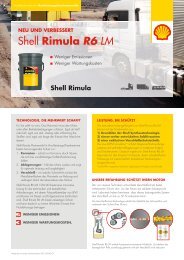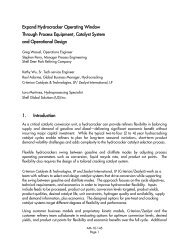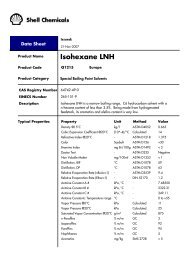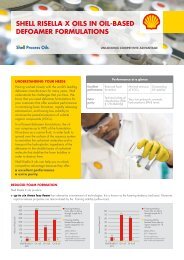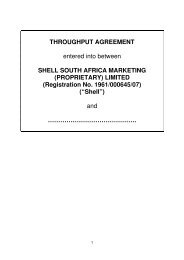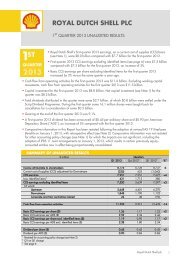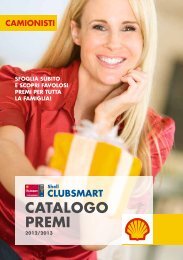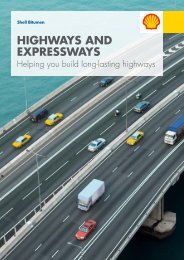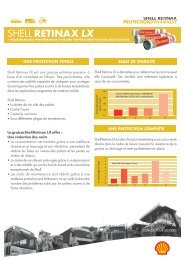Marine Cargo Handling Sheet IPA Isopropyl Alcohol
Marine Cargo Handling Sheet IPA Isopropyl Alcohol
Marine Cargo Handling Sheet IPA Isopropyl Alcohol
Create successful ePaper yourself
Turn your PDF publications into a flip-book with our unique Google optimized e-Paper software.
<strong>Cargo</strong> <strong>Handling</strong> <strong>Sheet</strong><br />
<strong>IPA</strong> <strong>Isopropyl</strong> <strong>Alcohol</strong><br />
Document date: 1 March 2012<br />
Revision 2
<strong>Cargo</strong> handling <strong>Sheet</strong>: <strong>IPA</strong><br />
Document date: 1 March 2012<br />
Revision 2<br />
Product Details:<br />
Product Name:<br />
IMO Shipping Name:<br />
Chemical Family:<br />
Product Code:<br />
<strong>Isopropyl</strong> <strong>Alcohol</strong><br />
<strong>Isopropyl</strong> <strong>Alcohol</strong><br />
<strong>Alcohol</strong>s<br />
S1111<br />
MSDS:<br />
http://www.euapps.shell.com/MSDS/GotoMsds?loc=shellchemicals<br />
Physical Properties:<br />
Density: 0.785 kg/l @ 20 deg C.<br />
Specific Gravity: 0.78 – 0.79 @ 20 deg C.<br />
Viscosity: 2.4 (mPas) @ 20 deg C.<br />
Vapor Pressure: 4,100 (Pas) @ 20 deg C.<br />
Boiling Point: 82 Deg C.<br />
Melting Point: -88 Deg C.<br />
Flash Point: 12 Deg C.<br />
Notes:<br />
Transshipments are not permitted unless the responsible Shell Chemical charterer has been<br />
consulted and the operation approved by the t<br />
Regional <strong>Marine</strong> Technical Advisor.<br />
Marpol Details:<br />
Marpol Annex:<br />
II<br />
IMO Ship Type: 3 Shell Chemicals requires a ship type 2<br />
IMO Pollution Category:<br />
Oil Like:<br />
High Viscosity:<br />
Solidifying:<br />
Z<br />
No<br />
No<br />
No<br />
USCG: USCG compatibility group 20, not compatible with group 12<br />
Isocyanates.<br />
2
<strong>Cargo</strong> handling <strong>Sheet</strong>: <strong>IPA</strong><br />
Document date: 1 March 2012<br />
Revision 2<br />
<strong>Cargo</strong> <strong>Handling</strong> Requirements:<br />
All shore and ship cargo lines and tanks are to be presented clean (residual free), dry, odor free,<br />
and rest free, with good gaskets and pressure tested heating coils.<br />
Prepurging of Vessel’s Tanks:<br />
N2 Blanket Required:<br />
Percent Oxygen in Nitrogen Blanket:<br />
Loading Temperature Range:<br />
Transit Temperature Range:<br />
Discharge Temperature Range:<br />
Maximum Heating Coil Temperature:<br />
No<br />
No<br />
No<br />
Ambient<br />
Ambient<br />
Ambient<br />
Blanked off<br />
Adjacent Maximum <strong>Cargo</strong> Temperature: 30 Deg C.<br />
Regional Requirements:<br />
None noted at this time.<br />
Notes:<br />
Tank Acceptance Requirements:<br />
Stainless or Coated:<br />
Wall Wash Required:<br />
Wash Notes:<br />
Coated. Carrier to verify suitability of coating for<br />
product.<br />
May be required depends on previous product.<br />
Wash with product against sales specifications<br />
cGMP Prohibited Adjacent <strong>Cargo</strong> and Prior <strong>Cargo</strong> List<br />
Isopropanol (<strong>IPA</strong>) - USP/EP Grade<br />
This list applies to USP/EP product shipments in non-dedicated transportation equipment to protect<br />
end-users from either adulteration or contamination of the cargo. It is based in part on the NIOP<br />
Unacceptable Prior <strong>Cargo</strong> List, the FOSFA List of Banned Immediate Previous <strong>Cargo</strong>es, and the<br />
Codex Code of Practice for the Storage and Transport of Edible Fats and Oils in Bulk (Codex<br />
Alimentarius), and the Chapter 5.3 Criteria of the CEFIC Guidelines for <strong>Handling</strong> and Distribution<br />
3
<strong>Cargo</strong> handling <strong>Sheet</strong>: <strong>IPA</strong><br />
Document date: 1 March 2012<br />
Revision 2<br />
of Propylene Glycol USP/EP. In addition, the USP General Chapter 467 for Organic Volatile<br />
Impurities (now known as Residual Solvents) is cited, subject to the compositional limits therein.<br />
PLEASE NOTE: This is not an exhaustive listing; it is intended to be a reference guide. Any prior or adjacent cargo<br />
substances not shown on this list which have the potential risk of a hazardous exposure need to be thoroughly reviewed<br />
by the consignee or shipper with Shell Chemical prior to presentation of transport equipment for loading to determine<br />
any HSSE impact. These restrictions are applicable to 3 (three) cargos prior to loading <strong>IPA</strong>-USP grade product.<br />
SUBSTANCE<br />
Acetone cyanohydrin<br />
REASON TO BE ON THE LIST<br />
Reactive with water.<br />
Decomposes to form Hydrogen Cyanide<br />
Acetonitrile<br />
Acrylates such as:<br />
Subject to USP General Chapter 467-Residual<br />
Solvents limits; Class 2 Solvents to be Limited<br />
Sensitizer; harmful by all routes of exposure<br />
butyl acrylate<br />
ethyl acrylate<br />
ethyl hexyl acrylate<br />
methyl acrylate<br />
methyl methacrylate monomer<br />
Acrylonitrile Carcinogen cat 2<br />
Adiponitrile<br />
Aldehydes, e.g.:<br />
Acetaldehyde<br />
Formaldehyde<br />
Gluteraldehyde<br />
Allyl compounds, e.g.:<br />
Allyl alcohol<br />
Toxic by ingestion.<br />
Carcinogen cat 3<br />
IARC 2 A carcinogen<br />
Toxic by inhalation and if swallowed, sensitizer, high<br />
aquatic toxicity<br />
Toxic; harmful by all routes of exposure; irritating to<br />
eyes, respiratory system, and skin; lacrymator; high<br />
aquatic toxicity<br />
Allyl chloride<br />
Allyl ligands<br />
4
<strong>Cargo</strong> handling <strong>Sheet</strong>: <strong>IPA</strong><br />
Document date: 1 March 2012<br />
Revision 2<br />
Allyl palladium chloride<br />
Amides, e.g.<br />
Acrylamide<br />
Dimethylformamide (DMF)<br />
N,N-dimethylacetamide<br />
Subject to USP General Chapter 467-Residual<br />
Solvents limits; Class 2 Solvents to be Limited<br />
Carcinogen cat 2, sensitizer<br />
Reproductive tox cat 2<br />
N,N-dimethlyformamide<br />
Amines, e.g.:<br />
Dibutylamine<br />
Diethanolamine<br />
Diethylenetriamine<br />
Diisopropylamine<br />
Ethanolamine<br />
Ethylenediamine<br />
n-propylamine<br />
Harmful by all routes of exposure<br />
Form nitrosamines, harmful if swallowed (R 48)<br />
Corrosive, sensitizer<br />
Corrosive<br />
Corrosive, harmful by all routes of exposure<br />
Corrosive, sensitizer<br />
Low odor threshold<br />
Corrosive<br />
hexamethylediamine<br />
Animal-origin products including lard, tallow, etc.<br />
Non-Kosher<br />
BSE/TSE “mad cow” exposure<br />
Aniline<br />
Carcinogen and mutagen cat 3, sensitizer<br />
Anisol<br />
Aromatic Hydrocarbons e.g.<br />
Benzene<br />
Ethylbenzene<br />
Naphthalene<br />
Toluene<br />
Xylene (mixed isomers and o-, m-, p-)<br />
Carcinogen cat 1<br />
IARC 2 B<br />
Carcinogen cat 3, toxic to aquatic organisms<br />
Reprotox cat 3, neurotox effects<br />
Harmful by inhalation/skin contact, contains EB<br />
Subject to USP General Chapter 467-Residual<br />
Solvents limits; Class 1 Solvents to be Avoided<br />
5
<strong>Cargo</strong> handling <strong>Sheet</strong>: <strong>IPA</strong><br />
Document date: 1 March 2012<br />
Revision 2<br />
Aromatic Hydrocarbon Solvents (> 8% aromatics)<br />
May contain benzene<br />
Bisphenol A<br />
1,3-butadiene<br />
Caprolactam<br />
Chlorinated compounds, e.g.:<br />
Carbon tetrachloride<br />
Ethylene dichloride<br />
Epichlorhydrin<br />
Chlorobenzenes<br />
Chloroform<br />
Chloroprene<br />
1,2-dichloroethane<br />
1,2-dichloroethene<br />
1,1-dichloroethene<br />
1,1,1- trichloroethane<br />
1,3-dichloropropene (“TELONE”)<br />
Methylene chloride<br />
Perchloroethylene<br />
Trichloroethane<br />
Trichlorethylene<br />
Suspected carcinogens; discussion on hormone<br />
disrupting effects<br />
Carcinogen cat<br />
Harmful by all routes of exposure.<br />
Dioxins, PCBs<br />
Carcinogen cat 3; toxic by inhalation,<br />
Carcinogen cat 2<br />
Carcinogen cat 3, corrosive, sensitizer<br />
Harmful by inhalation, aquatic toxicity<br />
Carcinogen cat 3, harmful by inhalation<br />
Carcinogen cat 2<br />
Toxic; environmental hazard<br />
Toxic; environmental hazard<br />
Toxic; environmental hazard<br />
Toxic; environmental hazard<br />
Fumigant, reference NIOP list<br />
Carcinogen cat 3<br />
Carcinogen cat 3, aquatic toxicity<br />
Harmful by inhalation, ODC properties<br />
Carcinogen cat 1<br />
Vinyl chloride monomer<br />
Coal tar and coal tar pitch, e.g.:<br />
Creosote (coal tar or wood)<br />
Cresol (o,m,p and cresylates and cresylic acids)<br />
Carcinogen cat 2<br />
Carcinogen cat 2<br />
Corrosive, toxic if contact with skin<br />
6
<strong>Cargo</strong> handling <strong>Sheet</strong>: <strong>IPA</strong><br />
Document date: 1 March 2012<br />
Revision 2<br />
Cyclohexane<br />
Di-glycidyl ether of bisphenol A<br />
1,2-dimethoxyethane<br />
1,4-dioxane<br />
Divinylbenzene<br />
Epoxy resins (uncured)<br />
Ethylene dibromide<br />
Ethylene glycols, e.g.:<br />
monoethylene glycol MEG<br />
diethylene glycol DEG<br />
Subject to USP General Chapter 467-Residual<br />
Solvents limits; Class 2 Solvents to be Limited<br />
Di-glycidyl ethers are suspected carcinogens;<br />
discussion on hormone disrupting effects<br />
Subject to USP General Chapter 467-Residual<br />
Solvents limits; Class 2 Solvents to be Limited<br />
Subject to USP General Chapter 467-Residual<br />
Solvents limits; Class 2 Solvents to be Limited<br />
Intermediate, associated with styrene<br />
Asthmogenic<br />
Carcinogen cat 2, environmental toxin<br />
Harmful if swallowed; toxic by ingestion<br />
Subject to USP General Chapter 467-Residual<br />
Solvents limits; Class 2 Solvents to be Limited<br />
triethylene glycol TEG<br />
ethylene glycol-based de-icing fluids<br />
ethylene glycol-based antifreeze<br />
Ethylene glycol ethers, e.g.:<br />
Ethylene glycol ethyl ether (ethoxy ethanol),<br />
Ethylene glycol ethyl ether acetate (ethoxy ethyl<br />
acetate),<br />
Several health hazards including reproductive toxicity<br />
Subject to USP General Chapter 467-Residual<br />
Solvents limits; Class 2 Solvents to be Limited<br />
Ethylene glycol methyl ether acetate (methoxy<br />
ethylacetate),<br />
Ethylene glycol methyl ether (methoxy ethanol),<br />
Ethylene glycol monobutyl ether (butoxyethanol),<br />
Ethylene glycol monoalkyl ether)<br />
Ethylene oxide Carcinogen and mutagen cat 2<br />
Furfuryl alcohol Harmful by all routes of exposure; IARC review –<br />
inadequate data<br />
7
<strong>Cargo</strong> handling <strong>Sheet</strong>: <strong>IPA</strong><br />
Document date: 1 March 2012<br />
Revision 2<br />
n-Hexane<br />
Isoprene<br />
Isocyanates such as :<br />
Subject to USP General Chapter 467-Residual<br />
Solvents limits; Class 2 Solvents to be Limited<br />
Carcinogen cat 2, mutagen cat 3, aquatic toxicity<br />
Asthmogenic, very reactive<br />
Cyanates<br />
Methylene diisocyanate (MDI)<br />
Methyl isocyanate<br />
Diphenyl methane diisocyanate (MDI)<br />
Polymethylenene polyphenylisocyanate<br />
Toluene diisocyanate (TDI)<br />
Lecithin<br />
Methanol<br />
Methyl n-butyl ketone (MBK)<br />
Methylcyclohexane<br />
Methyl styrene monomer<br />
n-Methyl Pyrrolidone<br />
Morpholine<br />
Morpholine ethanol<br />
Derived from plant/animal material, non-Kosher,<br />
BSE/TSE exposure<br />
Subject to USP General Chapter 467-Residual<br />
Solvents limits; Class 2 Solvents to be Limited<br />
Subject to USP General Chapter 467-Residual<br />
Solvents limits; Class 2 Solvents to be Limited<br />
Subject to USP General Chapter 467-Residual<br />
Solvents limits; Class 2 Solvents to be Limited<br />
Odor threshold<br />
Subject to USP General Chapter 467-Residual<br />
Solvents limits; Class 2 Solvents to be Limited<br />
Corrosive, harmful by all routes of exposure, IARC<br />
group 3<br />
Reference FOSFA list<br />
Nitrobenzene Carcinogen and reproductive toxin cat 3<br />
Nitromethane<br />
Nitropropane<br />
Noxious cargoes<br />
Harmful if swallowed, explosive upon heating<br />
Harmful by all routes of exposure<br />
Reference NIOP List<br />
8
<strong>Cargo</strong> handling <strong>Sheet</strong>: <strong>IPA</strong><br />
Document date: 1 March 2012<br />
Revision 2<br />
Pesticides-<br />
Reference CEFIC and FOSFA guidelines<br />
including biocides, insecticides, fungicides,<br />
herbicides, and rodenticides<br />
Petroleum Products other than De-aromatized<br />
Hydrocarbon Solvents (e.g. ShellSol D-grades)<br />
Phenol<br />
Phthalates,e.g.:<br />
Dioctyl phthalate<br />
May contain benzene<br />
Mutagen cat 3, toxic by all routes of exposure,<br />
corrosive<br />
Although some suspect as a human carcinogen;<br />
IARC concluded not a human carcinogen (group 3)<br />
(effects in lab animals related to peroxisome<br />
proliferation)<br />
Propylene oxide Carcinogen and mutagen cat 2<br />
Pygas<br />
Pyridine<br />
Resins, Curing Agents, Hardeners, Modifiers, and<br />
Tackifiers<br />
Sulfolane<br />
Styrene Monomer<br />
Tall Oil and Tall Oil Fatty Acid<br />
Tetrahydrofuran<br />
Tetralin<br />
Toluidine<br />
Trichloroacetic acid<br />
Trifluoroacetic acid<br />
Tricresyl phosphate<br />
Contains benzene<br />
Harmful by all routes of exposure, IARC group 3, low<br />
odor threshold; Subject to USP General Chapter<br />
467-Residual Solvents limits; Class 2 Solvents to be<br />
Limited<br />
Skin irritating and sensitizing properties<br />
Subject to USP General Chapter 467-Residual<br />
Solvents limits; Class 2 Solvents to be Limited<br />
IARC 2B, tainting, low odor threshold<br />
Reference NIOP list<br />
Irritating, mutagenic/carcinogenic effects observed in<br />
animals<br />
Subject to USP General Chapter 467-Residual<br />
Solvents limits; Class 2 Solvents to be Limited<br />
IARC 2 B<br />
Corrosive<br />
Corrosive<br />
Under NTP review (carcinogen, reproductive toxin)<br />
9
<strong>Cargo</strong> handling <strong>Sheet</strong>: <strong>IPA</strong><br />
Document date: 1 March 2012<br />
Revision 2<br />
Vinyl acetate monomer<br />
IARC 2 B<br />
Maintenance of heating coils is to be verified in the ship’s log. If product is to be heated, heating<br />
coils are to be confirmed leak free. If Product is not heated, heating coils are to be drained, dried<br />
and blanked off.<br />
Safety Information and Incident Reporting.<br />
Safety Information:<br />
For more detailed information, refer to the MSDS or e-SDS for reportable spill/release quantities<br />
whether in the water, air or ground.<br />
Incident Reporting:<br />
If an incident occurs outside the territorial limits of the USA, call Shell International Trading and<br />
Shipping in London on (44) 207-934-7777. If the spill/release marine incident occurs within the<br />
territorial limits of the USA, call the Shell 24 hr. incident number at 713-241-2532. The USA<br />
National response center telephone number is 1-800-424-8802<br />
For additional marine cargo handling advice or information, contact Captain Eddie Trotter at (+1<br />
713 241 3535)<br />
Shell Chemical LP<br />
PO Box 4407<br />
Houston<br />
Texas 77210<br />
USA<br />
Tel +1 866 897 4355<br />
Internet http://www.shell.com/chemicals<br />
Disclaimer<br />
The information contained in this publication is, to the best of our knowledge, true and accurate, but any recommendations or suggestions that<br />
may be made are without guarantee, since the conditions of use are beyond our control. Furthermore, nothing contained herein shall be<br />
construed as a recommendation to use any product in conflict with existing patents covering any material or its use.<br />
Shell Chemicals<br />
The expression “Shell Chemicals” refers to the companies of the Shell Group of companies that are engaged in the chemical businesses.<br />
Each of the companies that make up the Shell Group of companies is an independent entity and has its own separate identity.<br />
10



